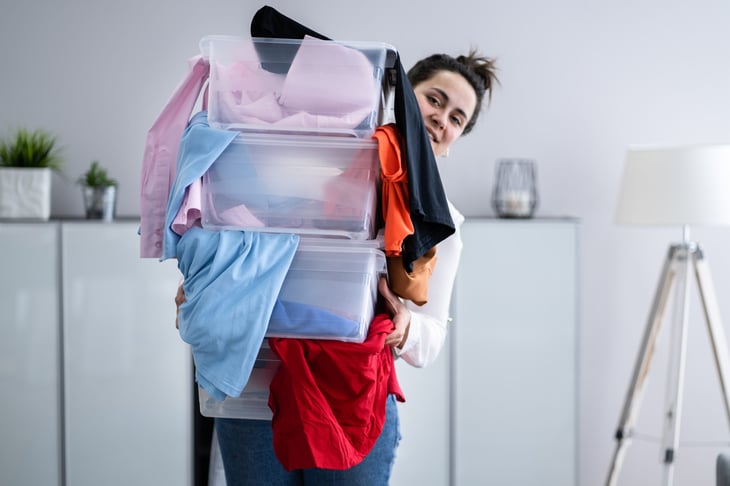
Editor's Note: This story originally appeared on Living on the Cheap.
Have you ever come home from a successful shopping expedition, or stacked up all your gifts from the latest holiday or birthday, and wondered: Where am I going to put this stuff?
The best way to find places for all your new stuff is by organizing what you have and getting rid of an equal amount of old stuff — because clutter costs.
It costs you time looking for things you have but can’t find and costs you money buying things you don’t need because you can’t find the old ones. You are going to get organized once and for all. Or at least for once.
Step 1: Put like things together

That means putting all your shampoo in one place and all your sandals in another. If you have tomato sauce in your pantry and tomato sauce in a kitchen cabinet, get all that tomato sauce together.
This simple step is one of the first rules of organizing. I once moved in with someone who had so many unused (and forgotten) bottles of shampoo scattered around her apartment that when she organized them, she didn’t have to buy any shampoo for a year.
If you don’t have a lot of storage space, getting all your similar things together may require some time and effort, but persevere. It is worth it.
Step 2: Get rid of things you don’t love

You may discover, as you put all your “like” things together, that you just don’t have enough storage space for some things. No, you may not rush to the Container Store and buy a bunch of cute storage gear. That is not cheap.
What you must do first is sort ruthlessly through your things and decide what you don’t really need. We spend a lot of money, as well as time, organizing, reorganizing, dusting and moving stuff we never use.
Take a critical look at your clothes, tools, kids’ toys and kitchen equipment. Which have you used in the past year? Which toys do your kids really play with? Which books and decorative objects bring you pleasure and which do you keep only because Aunt Martha gave them to you?
The traditional advice is to sort into three piles: stuff you know you will keep, stuff you know you will give away and stuff you’re not sure about and will revisit later. Those categories are good, but add a fourth: stuff you think you can sell.
Be tough. If you have things you’re not using now but think you may need in the future, weigh the cost of storage versus the cost of buying new ones down the road.
Are there possessions you’re not using you can lend to family members who will use them? My brother-in-law is getting a lot more use out of the fancy stand mixer I just had to have than I ever did. Maybe I will never ask for it back.
If you are convinced you truly do not have enough shelving or storage containers, see what you can find on online marketplaces or at clearance sales. But your goal should be to pare down your stuff to fit into the storage space you have, not to go out and buy more storage material.
Step 3: Sell stuff you no longer want

As you work your way through your home, ruthlessly identifying the items you plan to boot out, you’ll probably find a few things you think you could sell. Selling secondhand goods is big business, whether it’s on eBay, on Facebook Marketplace, in yard sales or at a consignment shop.
Following are some places to sell items.
Craigslist

I’ve found this the best place to sell furniture and larger household items. I find it most efficient to do all my Craigslist selling in a weekend.
If you’re not comfortable having people come to your house while you’re there alone, ask a friend to come by while people visit. Tell people in your ad whether you are willing to communicate by text, email or phone.
Don’t hold things for people, take cash only and trash any emails you get asking that goods be shipped. I’ve bought and sold several households of furniture on Craigslist without any problems. If you can deliver what you’re selling, you can do even better.
eBay

This works well for some people and not so well for others. See how items like yours are selling before you set up shop. Be sure to check what eBay will charge you in commission to determine whether an item is worth selling. If you have a friend with an established account, you might want to work with him or her rather than start a new account.
Amazon

Selling items on Amazon is easier than selling them on eBay, and it can be an excellent way to sell books, CDs and other items — if you have the right items. Best-sellers and popular novels often sell for only a penny, while lesser-known books sell quite well. I sold an out-of-print commercial real estate textbook for $220, minus Amazon’s cut. But the vast majority of my books weren’t worth the time it would take to list them.
Facebook Marketplace

If you have a Facebook account, their Marketplace is another online option for selling at no cost to you.
Consignment store

If you have clothing, costume jewelry and household items in nearly new condition, check with these stores. They will put the items in their stores and give you a percentage of what they earn when the item sells.
Most consignment stores are picky about what they will take, and “gently used” is usually not good enough.
Jewelry stores

Start with a reputable local jeweler. Some pieces may be worth more intact, while others are worth only the wholesale value of the gold. It’s OK to get a second opinion. Be wary of companies that ask you to mail in your items.
Yard sale

I swore off yard sales when I netted $25 for two full days of work. But my brother and sister-in-law make hundreds of dollars from yard sales. It depends on your location and the items you have to sell. Consider collaborating with family and friends at the home with the best location.
Friends

I’ve sold household items and furniture by sending emails to my friends. Your too-small purse may be someone else’s just-the-right-size bag.
If you’re not sure whether the items you want to discard have any monetary value, spend some time on the internet, checking eBay and other sites to see what people are asking for similar items.
Most important, factor in the time it will take you to sell your stuff, whether it’s holding a yard sale or packing up items and standing in line at the post office. If you discover that your stuff isn’t worth the time it would take you to sell it, donate it to a charity.
Recycling is good for the soul.





Add a Comment
Our Policy: We welcome relevant and respectful comments in order to foster healthy and informative discussions. All other comments may be removed. Comments with links are automatically held for moderation.